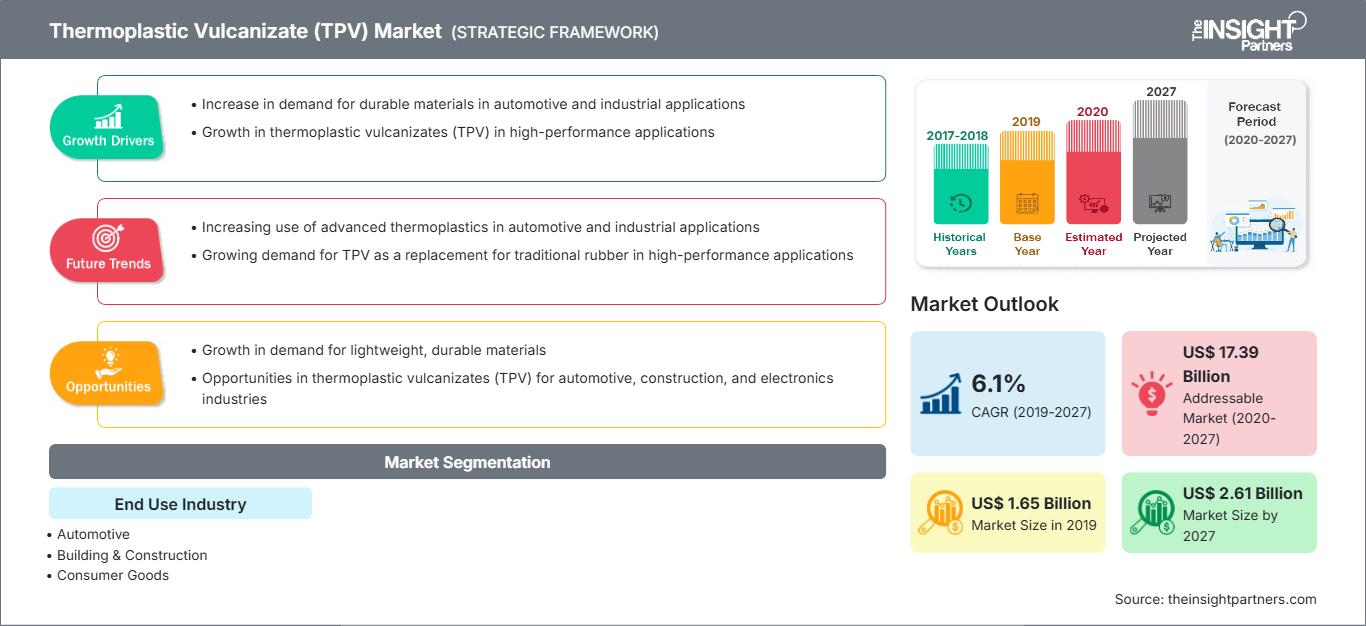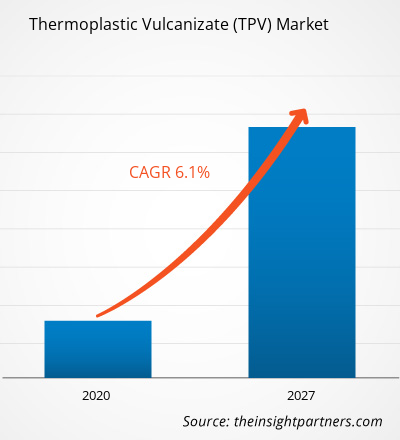The thermoplastic vulcanizate (TPV) market was valued at US$ 1,646.78 million in 2019 and is projected to reach US$ 2,612.50 million by 2027; it is expected to grow at a CAGR of 6.1% during the forecast period.
Thermoplastic vulcanizates are used in a wide variety of products such as washers and dryers, dishwashers, small appliances, grips and seals & refrigerators, for rigid parts and seals. The demand for thermoplastic vulcanizates in the consumer goods sector is expected to increase owing to its benefits of lightweight, versatile, and soft materials in different application areas, including clothing, home appliances, personal care products, kitchenware, and power tools. Further, the growth of the consumer goods industry in BRIC nations is also expected to have a positive impact on the thermoplastic vulcanizates market. Thermoplastic vulcanizations (TPVs) provide excellent efficiency, reduced system costs, and potential sustainability. Owing to these benefits, TPVs are used in the consumer goods industry. For instance, ExxonMobil Chemical produces thermoplastic vulcanizates (TPVs) with high-performance elastomers that provide versatility in production, ease of processing, and durability. By providing superior and consistent performance across industrial and challenging consumer applications, TPV offers the potential for lower device costs, reduced weight, and recyclability compared to materials such as EPDM (ethylene propylene diene polymethylene backbone) or other thermoset rubbers.
North America is expected to hold the largest share of the global thermoplastic vulcanizate (TPV) market during the forecast period. Several domestic and international companies have a strong foothold in the North American region. The growth of the thermoplastic vulcanizate (TPV) market in this region is primarily attributed to the growing demand for lightweight materials for the production of several auto components. Further, favorable government regulations pertaining to TPV consumption in automotive applications as an alternative to alloys and metals, along with increasing passenger car production in the US and Mexico, are expected to further fuel regional market growth over the forecast period. Further, technical developments and growing demand for electric vehicles have increased the need for lightweight, robust, and recyclable goods, which, in turn have propelled the market growth.
The US, India, Brazil, Russia, France, the UK, Turkey, Italy, and Spain are among the most-affected nations in terms of confirmed cases and reported deaths due to COVID-19, as of December 2020. According to the WHO data as of December, 2020, ~80,453,105 affirmed cases and 1,775,776 deaths have been reported in the world. The COVID-19 pandemic has affected economies due to lockdowns, travel bans, and business shutdowns. The global chemicals and materials industry is one of the major businesses enduring supply chain breaks and manufacturing disruptions due to these restrictions. China is the global hub of manufacturing and the largest raw material supplier for various industries. The lockdown of various plants and factories leading regions, such as Asia Pacific and Europe, is affecting the global supply chains and negatively impacting the manufacturing, delivery schedules, and product sales. These factors have adversely affected the global thermoplastic vulcanizate (TPV) market growth.
Customize This Report To Suit Your Requirement
You will get customization on any report - free of charge - including parts of this report, or country-level analysis, Excel Data pack, as well as avail great offers and discounts for start-ups & universities
Thermoplastic Vulcanizate (TPV) Market: Strategic Insights

-
Get Top Key Market Trends of this report.This FREE sample will include data analysis, ranging from market trends to estimates and forecasts.
Market Insights
Use of Bio- Based Thermoplastic Vulcanizate
In order to minimize reliance on non-renewable resources, such as petroleum, and to achieve sustainable development of the polymer materials industry, a large number of people prefer bio-based polymer materials. Bio-based thermoplastic vulcanizates (TPV) are made of poly(lactide) (PLA) and ethylene-co-vinyl acetate rubber (EVA) that have been fabricated using dicumyl peroxide (DCP) as a curing agent; it is the first time that the application of PLA in elastic materials has been demonstrated. As bio-based TPVs contain low carbon emissions and are biodegradable in nature, synthesis of the same is encouraged in most countries. They are currently considered to be sustainable alternatives for traditional petroleum-based polymers since they are derived from renewable resources such as starch-based polymers, polylactides (PLAs), polyhydroxyalkanoates(PHAs), cellulose-based polymers, and soy-based polymers. As bio-based TPEs not only provide a clean solution but also offer bio-based TPE producers cost competitiveness against their synthetic counterparts, they are expected to create significant market growth opportunities.
End Use Industry Insights
Based on end use industry, the thermoplastic vulcanizate (TPV) material market is segmented into automotive, building and construction, consumer goods, healthcare, and others. In 2019, the automotive segment dominated the market. Automotive lightweight materials have witnessed strong growth over the last few years owing to the growing demand for luxury, low-emission, safe, and high-performance vehicles. As a result, suppliers and manufacturers have launched a number of solutions that not only help OEMs comply with strict regulations but also meet the expanding range of personal customer demands. TPVs are also a reasonable alternative to expensive elastomers. They offer excellent elastomeric durability, including relatively high tensile strength and elongation at break time, high elastic recovery as well as good dimensional stability in hot air, and excellent resistance to UV aging, ozone, and weathering. The key applications of TVP in the automotive industry include hose covers, air inlet duct covers, gaskets, seals, convoluted boots, vibration-dampers, strut covers, ignition parts, bushings, and window seals. Flexible TPV automotive under-the-hood components include air intake tubes and bellows, well flares of the wheel, bellows of the steering system, and sound abatement parts. Further, the cost of TPVs is considered 10–30% percent lower than EPDM, combined with a lower weight, enhanced versatility of design, and recyclability.
Mitsui Chemicals Inc., Celanese Corporation, Mitsubishi Chemical Corporation, Kumho Polychem, Trinseo, Teknor Apex, ExxonMobil, Zeon Chemicals L.P., Alphagary and Ravago are among the key players present in the global thermoplastic vulcanizate (TPV) market. These companies are implementing new product development, and merger and acquisition strategies to enlarge their respective clientele and gain significant market share in the global market, which, in turn, allows them to maintain their brand name.
Report Spotlights
- Progressive industry trends in the global thermoplastic vulcanizate (TPV) market that help players develop effective long-term strategies
- Business growth strategies adopted by developed and developing markets
- Quantitative analysis of the global thermoplastic vulcanizate (TPV) market from 2017 to 2027
- Estimation of global thermoplastic vulcanizate (TPV) demand across various industries
- PEST analysis to illustrate the efficacy of buyers and suppliers operating in the industry
- Recent developments to understand the competitive market scenario and global thermoplastic vulcanizate (TPV) demand
- Market trends and outlook, and factors driving and restraining the growth of the global thermoplastic vulcanizate (TPV) market
- Understanding the strategies that underpin commercial interest with regard to the market growth
- Global thermoplastic vulcanizate (TPV) market size at various nodes of market
- Detailed overview and segmentation of the market, as well as its industry dynamics
- Global thermoplastic vulcanizate (TPV) market size in various regions with promising growth opportunities in the respective regions
The regional trends and factors influencing the Thermoplastic Vulcanizate (TPV) Market throughout the forecast period have been thoroughly explained by the analysts at The Insight Partners. This section also discusses Thermoplastic Vulcanizate (TPV) Market segments and geography across North America, Europe, Asia Pacific, Middle East and Africa, and South and Central America.
Thermoplastic Vulcanizate (TPV) Market Report Scope
| Report Attribute | Details |
|---|---|
| Market size in 2019 | US$ 1.65 Billion |
| Market Size by 2027 | US$ 2.61 Billion |
| Global CAGR (2019 - 2027) | 6.1% |
| Historical Data | 2017-2018 |
| Forecast period | 2020-2027 |
| Segments Covered |
By End Use Industry
|
| Regions and Countries Covered |
North America
|
| Market leaders and key company profiles |
|
Thermoplastic Vulcanizate (TPV) Market Players Density: Understanding Its Impact on Business Dynamics
The Thermoplastic Vulcanizate (TPV) Market is growing rapidly, driven by increasing end-user demand due to factors such as evolving consumer preferences, technological advancements, and greater awareness of the product's benefits. As demand rises, businesses are expanding their offerings, innovating to meet consumer needs, and capitalizing on emerging trends, which further fuels market growth.

- Get the Thermoplastic Vulcanizate (TPV) Market top key players overview
Thermoplastic Vulcanizate (TPV) Market, byEnd Use Industry
- Automotive
- Building & Construction
- Consumer Goods
- Healthcare
- Others
Company Profiles
- Mitsui Chemicals Inc.
- Celanese Corporation
- Mitsubishi Chemical Corporation
- Kumho Polychem
- Trinseo
- Teknor Apex
- ExxonMobil
- Zeon Chemicals L.P.
- Alphagary
- Ravago
Frequently Asked Questions
Based on type, why is the automotive segment expected to grow at the highest rate during 2019-2027?
Can you list some of the major players operating in the global thermoplastic vulcanizate (TPV) market?
Which region held the largest share of the global thermoplastic vulcanizate (TPV) market?
- Historical Analysis (2 Years), Base Year, Forecast (7 Years) with CAGR
- PEST and SWOT Analysis
- Market Size Value / Volume - Global, Regional, Country
- Industry and Competitive Landscape
- Excel Dataset
Recent Reports
Testimonials
Reason to Buy
- Informed Decision-Making
- Understanding Market Dynamics
- Competitive Analysis
- Identifying Emerging Markets
- Customer Insights
- Market Forecasts
- Risk Mitigation
- Boosting Operational Efficiency
- Strategic Planning
- Investment Justification
- Tracking Industry Innovations
- Aligning with Regulatory Trends





















 Get Free Sample For
Get Free Sample For